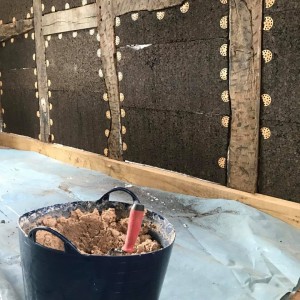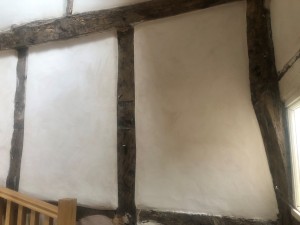There’s a line in the Discworld book The Truth, by Terry Pratchett, that goes:
“A lie can run around the world before the truth has got its boots on.”
Case in point: if you have or suspect bats in your house, They say that it’ll cost you one meeeeeeeeellion dollar to do any works you had planned, if you’re allowed to at all.
Honestly, the number of people who have said to us, when we’ve mentioned bats or newts, “Ooh don’t say anything because otherwise you won’t be allowed to do any work or make any changes and you’ll get prosecuted etc. etc. etc.”
I always suspected that was batbullshit, and I was right. Plus, we are tree-huggers and we are happy to host bats and newts. Bats eat midges. Newts are awesome.
(There are fascinating psychological reasons why this kind of nonsense story perpetuates despite a screaming lack of any evidence, and if you’re interested — and you should be — check out the book Made to Stick by Chip and Dan Heath.)
Anyway, back to the batshit.
The next mini-project in the ongoing saga of The Dingle is the Stone Room on the first floor. It is to become the Most Magnificent Bathroom in the World.
There’s plenty to do in there, and you’ll be able to follow along as we go… but one of the first jobs was to pull down the ceiling and put a new one in.
Because the current ceiling is made of spiderwebs, cheese, cheap bolts, and hope.
When we had our new boiler fitted (blog post to follow about that shortly), we were finally able to drag the water tanks out of the loft space above the Stone Room and get rid of them. When we went up there to do that, we noticed what a shocking state the ceiling was in.
And we also noticed this:

A giant pile of poo
Which is a giant pile of what we thought was bat poo. Certainly very small poos, and lots of it.
We did some googling, crumbled it between our fingers, and came to the conclusion that it was probably bat poo.
Plus, we know we have lots of bats flying around The Dingle of an evening, and although we’ve never paid that much attention to where they appear from and disappear to, old houses are perfect for bats.
So I called the Bat Conservation Trust for advice.
(Actually, I called a consultant I found on the internet, and we had a chat, and he recommended I contact the BCT because they do free checks and advice, whereas we’d be paying him. Good man. Thank you.)
Today, a volunteer and a trainee volunteer from the BCT arrived and had a look around. In ordinary times, they’d have come in and poked around themselves, but COVID has scuppered that kind of thing, so we got modern and used technology.
They asked for samples of the poo, and we FaceTimed around the loft space.
Up I went in my overalls to stagger around on the ceiling (did I mention it’s made of cheese and spiderwebs and isn’t fit to support anyone let alone a person?) and gather little pots of poo.
The poo from the main pile was definitely bat poo. They’ve taken it away to see if they can identify what species we have. And the poo from the other end was bird poo and mouse poo. Which is good news for us if the bats are only at one end of the roof space.
We’re quite keen to get this sorted because there’s water ingress when it rains on the interior wall, where the flashing has come away from the roof-wall interface. You can see the water damage here:

Not really dry…
Ken our timber guy reckons it’ll be fine with a bit of reinforcing which is grand because we DO NOT want to replace the purlin and do major roof works. Plus that will require all sorts of licences for the bats.
And at the other end, there are large holes between the wall and the roof, and some of the fascias are rotting so we’ll need to replace/repair and cover those, and we need to know what we can do.

Daylight where daylight should not be
The volunteers are going to write up their report over the next day or so, and put it through to Natural England as an urgent job for us.
We expect to hear back in 2—4 weeks, and he said it’ll probably be more like 2 weeks.
They could not have been more helpful. Their main aim is twofold: to protect the bats AND to enable us to get on with the work we want to do as quickly and inexpensively as possible.
They’re well aware of the nonsense people believe: that conservationists deliberately make it difficult for people to do work.
Of course they don’t. It’s not in their interests. Because when they make it difficult for people, people don’t declare bats and do all sorts of stuff that harms the bats.
Bats are great: they don’t cause damage, most of the time we don’t even know they’re there, and they eat tons of insects. A common pipistrelle bat can eat 3,000 midges and mozzies and flies in a single night!
And it’s really easy and inexpensive to provide for them.
The only issue really is timing: they build maternity roosts from around May until the end of August, so we won’t be allowed to do any work that could affect access between those dates.
That won’t be a problem for us, we’ve timed it well. We’ll be able to build the new ceiling and block the loft space off, leaving the bats in peace until the end of summer. Then we can go back up and do any further work we need to do.
Probably what we’ll have to do is partition off a portion of the loft space for the bats, and then put a droppings tray on the boarded out floor so we can remove droppings once a year. (Which is cool because bat droppings are fantastic fertiliser for my vegetable beds.)
We’re fine with that. It’ll cost us a few quid and we can do the work ourselves, and we’ll be helping the bats, which makes everyone happy.
So, if you suspect bats in your house, and you’re worried about it scuppering your plans to renovate or repair: don’t be.
Ignore people who like spread rumours without having facts, and give the Bat Conservation Trust a call. Their volunteers are super-friendly and helpful, and will work with you to do the best for you and the bats.
Thank you BCT!






